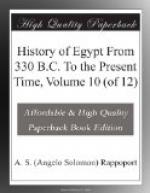[Illustration: 234.jpg THE APOTHEOSIS OF HOMER]
These were the palmy days of criticism. Never before or since have critics held so high a place in literature. The world was called upon to worship and do honour to the poet, but chiefly that it might admire the skill of the critic who could name the several sources of his beauties. The critic now ranked higher than a priest at the foot of Mount Parnassus. Homer was lifted to the skies that the critic might stand on a raised pedestal among the Muses. Such seems to be the meaning of the figures on the upper part of the well-known sculpture called the Apotheosis of Homer. It was made in this reign; and at the foot Ptolemy and his mother, in the characters of Time and the World, are crowning the statue of the poet, in the presence of ten worshippers who represent the literary excellences which shine forth in his poems. The figures of the Iliad and Odyssey kneel beside his seat, and the Frogs and Mice creep under his footstool, showing that the latter mock-heroic poem was already written and called the work of Homer.
Other celebrities who flourished under the fifth Ptolemy were Pamphilius, an Alexandrian physician who wrote on medical plants; Meander, a poet and physician who studied poisons, and the great Hipparchus, the founder of mathematical astronomy. Hero, also, in this reign, invented a kind of primitive steam-engine.
[Illustration: 235.jpg HERO’S ROTATING STEAM ENGINE]
These men and their contemporaries were in the habit of writing their scientific observations in the form of poetry, but it was verse without earnestness and feeling, and such of it as survives is valued not for its literary qualities or charms of diction, but for the side-lights it throws upon the manners and education of the age.
The portrait of the king is known from those coins which bear the name of “King Ptolemy the mother-loving god.” The eagle on the other side of the coins has a phoenix or palm-branch on its wing or by its side, which may be supposed to mean that they were struck in Phoenicia. We have not before met with the title of “god,” on the coins of the Ptolemies; but, as every one of them had been so named in the hieroglyphical inscriptions, it can scarcely be called new.




